The Imaging Resource
Quick Review
Fujifilm FinePix A345 Digital Camera
| Fujifilm FinePix A345 Digital Camera | ||
| Review Date |
|
|
| User Level |
|
|
| Product Uses |
|
|
| Digital Camera Design |
|
|
| Picture Quality |
Good, 4.1-megapixel CCD | |
| Print Sizes |
8x10s, sharp 5x7s | |
| Availability |
Now | |
| Suggested Retail Price |
|
|
Introduction - Fujifilm FinePix A345
|
|||||||||
The Fuji FinePix 350 and its $249.95 4.1-Mp twin the FinePix 345 share not only a trim, rectangular body style in a sleek metal finish but the manual as well. The latest models in the "A-Series" line, their retractable 3x zoom lenses include an automatic lens cover, dispensing with the sliding cover of previous models. At 3.5 x 2.4 x 1.2 inches (90 x 60 x 30.3 millimeters), the new models are smaller and more compact than their predecessors, easily slipping into a shirt pocket, a purse (nearly a coin purse) or small leather pouches. They're only a little taller than a credit card, if quite a bit thicker.
Both new models also enjoy a boost in image quality and overall performance. To process data from the FinePix A345's 4.1-Mp CCD and the FinePix A345's 4.1-Mp CCD, both cameras use new image processors that produce more robust color and enable quicker frame-to-frame shooting. Also new on these models are larger, 2.5-inch LCD monitors. And Movie mode now can capture sound, too.
The Fuji A345 shares the operational simplicity of past models, with fully automatic exposure complemented by a "Manual" mode that lets you set exposure compensation and white balance. In addition, four Scene modes are available to shoot Portrait, Landscape, Sports and Night images. In full Auto mode, the camera handles everything including flash, unless it's suppressed. Manual mode lets you adjust exposure using exposure settings from -2.1 to +1.5 EV in 0.3 EV steps. It also lets you select one of seven manual White Balance settings, including Outdoors (good weather), Shade, Daylight Fluorescent, Warm White Fluorescent, Cool White Fluorescent or Incandescent. When the flash is active, the white balance setting for flash is used, regardless of the White Balance mode setting. Suppressing the flash enables the White Balance mode setting.
The Fuji A345's four Scene modes optimize camera settings for specific situations. Portrait enhances skin tones and sets a soft overall tone. Landscape sets the camera for shooting scenery in daylight with no flash. Sports gives priority to faster shutter speeds for capturing sporting events and Night does just the opposite, favoring slower shutter speeds up to a full two seconds for shooting evening and night scenes. A tripod is recommended for Night Scene mode. None of the Scene modes allow you to adjust Exposure Compensation or White Balance.
The new retractable Fujinon 3x optical lens ranges from 5.8-17.4mm (a 35-105mm 35mm equivalent), a moderate wide angle through a useful telephoto typical of point-and-shoot digicams. Maximum aperture ranges from f/2.8 to f/4.7, depending on the zoom position, and focuses in Normal mode from two feet (60 centimeters) to infinity. In Macro mode, the lens focuses from 2.4 inches to 2.6 feet (6 to 80 centimeters) but restricts the focal length to the wide angle setting. In addition to the 3x optical zoom, the FinePix A345 also offers as much as 4.1x digital zoom, which effectively increases the camera's zoom range to a total of 12.2x. Keep in mind though, that digital zoom decreases the overall image quality, since it just stretches the center pixels of the CCD image.
For composing images, the Fuji A345 offers both a real-image optical viewfinder as well as a generous and bright 2.5-inch color LCD monitor. The optical viewfinder sees only about 75-80% of the captured scene, so tight that you'll be forced to use the LCD display for any but the least critical framing. The LCD monitor reports some camera settings (but not shutter speed or aperture), and can overlay an aligment grid. The grid divides the image area into thirds, both horizontally and vertically, making it easier to line up tricky subjects.
The through-the-lens auto focus system uses contrast-detection to find the subject. Light sensitivity ranges automatically from the equivalent of ISO 64 to 400.
The built-in flash is rated as effective from 2.0 to 11.5 feet (0.6 to 3.5 meters), reaching 9.8 feet (3 meters) in telephoto and 2.6 feet (0.8 meters) in Macro mode. Flash modes include Auto, Red-Eye Reduction, Forced Flash, Suppressed Flash, Slow Synchro and Red-Eye Reduction with Slow Synchro. Slow Synchro leaves the shutter open a bit longer than normal to capture more of the ambient light, leaving the main exposure up to the flash itself. The stated range agrees well with our own tests, but we did find that this range is achieved by boosting the camera's ISO to 400, which results in very noisy images.
Image quality settings include two 4-Mp settings for 2304x1728-pixel images, Fine and Normal; 3:2 (the standard 35mm aspect ratio) at 2304x1602; a 2-Mp setting for 1600x1200; a 1-Mp setting for 1280x960; and a 640x480 VGA setting. Except for the 3:2 setting, image are captured with a 4:3 aspect ratio.
The Fuji A345's continuous Shooting mode captures images continuously if there is room on your memory card when you hold down the shutter button at the rate of 1.34 frames per second. The number of frames depends on the image quality setting. Three frames can be captured at 4-MP Fine, or 18 at VGA quality. Focus is set for the first frame and does not change through the sequence. The flash is suppressed, too. Self-Timer mode offers a 2 or 10 second delay between the time the Shutter button is pressed and when the shutter actually opens, so you can get into your own shots.
The Fujifilm FinePix A345's movie mode captures MPEGs with monaural sound at 15 frames per second in either 320x240- or 160x120-pixel frames. Zoom is disabled during recording. Recording starts and stops with a brief, full press of the Shutter button. As you record, the duration of the movie appears in a running counter on the LCD monitor. Maximum movie lengths depend on the size of and free space on your card. The included 16-MB card holds 65 seconds at the 320 setting, but a 512-MB card would capture 34.6 minutes.
The Fujifilm FinePix A345 features PictBridge support, which means you can connect it via the included USB cable to a Pict-Bridge printer and use the A345's Digital Print Order Format features to select images to print directly from the camera. Options include quantity per image (up to 99) and whether or not to imprint the date on the image. In addition, when the camera captures images, it records Exif Print Format data containing a variety of shooting information for optimal printing.
The Fuji FinePix A345 ships with a 16-MB xD-Picture Card. The xD-Picture Card itself is very tiny, rivaling the popular SD memory cards in size. I highly recommend picking up at least a 128-MB card right away, given the camera's 2304x11728-pixel maximum resolution size, though cards as large as 512-MB card are also available.
The Fuji A345 uses two AA-type batteries for power, either alkaline or NiMH, and an optional AC adapter is available. A set of single-use AA alkaline batteries comes with the camera, but I strongly recommend purchasing a couple of sets of high-capacity NiMH batteries and a good charger, and keeping a spare set of batteries charged at all times. See my "NiMH Battery Shootout" report to see which batteries currently on the market are best, and read my review of the Maha C-204W NiMH battery charger, my current favorite.
Images can be transferred from the Fujifilm FinePix A345 via the included USB cable. An optional USB pen drive accepts an xD-Picture Card, making an attractive alternative. A video cable for viewing images on a television set is also included as is a software CD with Macintosh and Windows versions of the capable FinePix Viewer.
Basic Features
- 4.1-megapixel CCD delivering images as large as 2,304 x 1,728 pixels.
- Real-image optical viewfinder (75% coverage).
- 2.5-inch color LCD monitor.
- Fujinon 3x, 35-105mm (35mm equivalent) lens.
- 4.1x digital zoom.
- Auto and Manual (EV and White Balance only), plus Portrait, Landscape, Sports and Night Scene modes.
- White Balance with six settings.
- Maximum aperture of f/2.8 to f/4.7, depending on lens zoom position.
- Shutter speeds from 1/2000 to two seconds, depending on exposure mode.
- Built-in flash with six modes.
- Auto ISO equivalent to 64 to 400.
- Contrast-type Auto focus using Multipoint TTL metering.
- Macro (close-up) lens setting.
- xD-Picture Card storage (16MB card included). Power supplied by two AA-type batteries or optional AC adapter.
- Interface software and USB drivers included for Windows and Macintosh computers.
Special Features
- Movie mode (with sound).
- PictBridge support.
- DPOF (Digital Print Order Format) compatibility.
- Exif Print to record optimized print settings.
- Two- or 10-second Self-Timer for delayed shutter release.
Recommendation
Lightweight, portable, and easy to use, the Fujifilm FinePix A345 digital camera offers the point-and-shoot convenience that novices enjoy, with the benefit of a 4.1-megapixel CCD and 3x optical zoom lens for good resolution and sharpness. Although exposure remains under automatic control, you can adjust Exposure Compensation and White Balance if needed, and the four scene modes are useful under common conditions. A simple, straightforward user interface means little or no downtime spent learning, and makes the Fuji A345 adept at shooting on the fly. For a "street" price just under $200, you get the color and clarity on which Fuji has built such a strong reputation, with the convenience of a very user-friendly camera design. Its simplicity and ease of use make this a good choice for a low-end "family" digital camera, or for any novice looking for a true "point & shoot" digital camera.
Its attractive silver shell measures 3.5 x 2.4 x 1.2 inches (90 x 60 x 30.3 millimeters), not much larger than a credit card, if a good deal thicker. The low-profile controls make it easy to slip the Fujifilm FinePix A345 into your shirt pocket or small purse. Its compact size makes the included wrist strap a security measure more than an accessory. Loaded with an xD-Picture Card and two AA batteries, it weighs just 6.8 oz. (193 grams).
The Fuji A345's front panel is dominated by the telescoping lens, which withdraws completely flush. The lens extends 7/8 inch when the camera is powered on in a Recording mode but remains retracted when powered on in Playback mode. A shutter-like lens cover automatically opens when the lens protrudes, eliminating the need for a lens cap. Also on the front panel are the flash, optical viewfinder window, microphone and the self-timer lamp. A thin, vertical finger grip is reinforced by a small thumb grip on the back panel.
On the right side of the camera (as viewed from the rear) is the wrist strap mount.
The opposite side of the camera houses the speaker, mini-B USB socket, DC In socket and the AV Out socket. All of the sockets are uncovered.
The FinePix A345's top panel is flat with low-profile buttons for Power and the Shutter.
The back panel is the business end of this camera. Along the top are the optical viewfinder, the three-position Mode switch (Playback, Movie and Still) and a rocker panel inherited from the A340 with click buttons on either side of the zoom rocker button. The left click button toggles Macro mode and the right button steps through the Flash modes. The 2.5-inch LCD monitor dominates the left corner, flanked by the Menu/OK button and the Display/Back button. The thumb grip and a slightly raised vertical ridge are tactile clues for gripping this small camera.
On the bottom panel of the FinePix A345 are the plastic tripod mount and the battery/memory card compartment. The tripod mount is off center and adjacent to the compartment latch hinge, making it impossible to swap batteries when the camera is mounted to a tripod. An xD-Picture Card is easily clicked into place and ejected by simply pressing down slightly to release the hidden catch. Two AA batteries are likewise easy to load, with a clearly visible legend to remind you which end is up.
With full automatic exposure control and only two manual adjustments available, the Fuji FinePix A345's user interface is very straightforward and quick to grasp. The Mode switch determines how the camera behaves when powered on. With the camera turned on, a single push of the Menu/OK button brings up the four-option menu, which is fairly limited and quick to navigate using the combination of arrow and zoom rocker buttons. In Manual shooting mode, two additional menus are available to set EV and White Balance, though you still don't have access to aperture or shutter speed. All camera controls other than basic Flash and Macro mode selections are accessed through the LCD menu system, so you should have no trouble shooting with the camera right out of the box.
Record-Mode Display
The Fuji A345's LCD monitor reports very basic information in Record mode, including the shooting mode, resolution setting, number of available images, and a central autofocus target. It also reports the flash mode, and settings for continuous shooting, Macro mode and the self-timer when activated. When necessary, warnings are displayed for battery level, auto focus and camera shake. Pressing the Display button enables an alignment grid, which divides the image area into thirds vertically and horizontally, for better framing of linear subjects. A third press disables the LCD monitor entirely.
Playback-Mode Display
In Playback mode, the main LCD display shows the file number and capture date for a few seconds. Pressing the Display button pulls up the nine-image index display. Using the Zoom rocker button, you can enlarge captured images as much as 3.6x, depending on the quality mode selected, the maximum playback zoom only available with the highest-resolution images.
External Controls
Shutter Button: Located on the far right of the camera's top panel, this button sets focus and exposure when halfway pressed, and fires the shutter when fully pressed.
Power Button: Just left of the Shutter button, this button turns the camera on and off.
Menu/OK Button: Directly below the On / Play button, this button displays the settings menu in any camera mode, and acts as the "OK" to confirm menu selections.
Disp/Back Button: Located on the bottom right of LCD monitor, this button controls the LCD monitor display, and activates the framing grid. It also disables the LCD monitor, so you can save battery power by framing images with the optical viewfinder. In Playback mode, this button also controls the information overlay, as well as enables a nine-image index display mode.
Zoom Rocker Button: Tucked between two arrow keys in the upper right corner of the camera's rear panel, this two-way rocker button controls the optical and digital zoom. In any settings menu, this button navigates up and down through menu selections. In Playback mode, this button controls the Playback Zoom feature, which enlarges captured images as much as 13x.
Right and Left Arrow Keys (see image above): Flanking the Zoom rocker button in the top right corner of the rear panel, these arrow keys navigate through captured images in Playback mode, as well as through menu selections in any settings menu. When an image has been enlarged, these keys also move around within the view.
In Record mode, the left arrow accesses the Macro shooting mode, and the right arrow key cycles through the available flash modes.
Camera Modes and Menus
Photography Record Mode: This mode allows the camera to capture still images. Exposure is automatically controlled, although a "Manual" option in the settings menu increases the menu selections to include Exposure Compensation and White Balance. Pressing the Menu button displays the following options:
- Quality: Sets the image resolution and quality to 4M Fine (2,304 x 1,728 pixels), 4M Normal (2,304 x 1,728 pixels), 3:2 (2,304 x 1,602 pixels), 2M (1,600 x 1,200 pixels), 1M (1,280 x 960 pixels), or 0.3M (640 x 480 pixels). Also shows approximately how many frames can be captured at each resolution with the installed card's remaining space.
- Self-Timer: Activates either the 2-second or 10-second Self-Timer, or disables the mode.
- Shooting Mode: Puts the camera into Auto, Manual, Portrait, Landscape, Sports, or Night modes.
- Continuous Shooting: Enables the camera to shoot continuously at 1.34 frames per second, or disables this feature.
- Exposure Compensation: (Manual mode only) Adjusts the overall exposure from -2.1 to +1.5 exposure equivalents (EV) in one-third-step increments.
- White Balance: (Manual mode only) Sets the white balance to Auto, Outdoors, Shade, Daylight Fluorescent, Warm White Fluorescent, Cool White Fluorescent, or Incandescent.
Set-Up/LCD Brightness: Adjusts the LCD brightness, and offers a variety of setup menu options.
- Image Display: Turns the post-image capture review screen on or off.
- Power Save: Turns the power save option on or off. If on, you have the choice of a two- or five-minute delay before the camera automatically shuts off due to inactivity.
- Format: Formats the xD-Picture Card, erasing all files (even protected ones).
- Beep: Enables the camera's beep sounds, with options for Low, High, or Off.
- Date/Time: Sets the camera's internal clock and calendar.
- Time Difference: This option lets you set the time for another time zone. For example, when traveling, you can specify the time at home and for where you are, and the time difference is applied to captured images.
- LCD: Turns the LCD monitor on or off. If on, the LCD monitor automatically comes on whenever the camera is set to the Still Image Record position. If off, you must enable the display via the Display button.
- Frame Number: Sets the camera to number each successive image continuously from memory card to memory card, or to reset numbering with each new memory card.
- USB Mode: Sets the USB mode to DSC or Print Mode. Print Mode supports PictBridge printing.
- Language: Sets the menu language to one of five languages.
- Video System: Sets the video signal timing to PAL or NTSC.
- Discharge: Discharges rechargeable batteries fully, so that they can be recharged from the base level. (Do not use with alkaline batteries, as this will eliminate the charge entirely.)
- Reset: Resets all camera settings to their defaults.
Playback Menu: The traditional green playback symbol is the left-most option on the Mode switch. Here, you can review captured images and movies, as well as manage files and set up images for printing. Pressing the Menu button displays the following options:
Erase: Deletes the current frame, or all frames on the memory card.
- DPOF: Marks/unmarks frames for printing on DPOF devices, with an option to include a date and time overlay.
- Protect: Write-protects the displayed image, preventing it from being accidentally erased or manipulated (except via card formatting). Also removes protection, and offers options to protect or unprotect all images on the card.
- Playback: Enables an automated slide show of all the captured images on the memory card, with options for transition styles.
- Trimming: Lets you crop an image and save it separately as a 3M, 2M or VGA file.
- Options: Displays the same settings as under the Record menu with a Volume option.
In the Box
In the box are the following items:
- Fujifilm FinePix A345 digital camera.
- 16MB xD-Picture Card.
- Two single-use, AA-type alkaline batteries.
- Wrist strap.
- USB cable.
- AV cable.
- Software CD-ROM.
- Instruction manual and registration card.
- Larger capacity xD memory card. (I recommend 64MB as a bare minimum, 128MB would be preferable.)
- xD-Picture Card USB Drive (DPC-UD), a compact USB card reader.
- Two sets (four) NiMH rechargeable batteries and charger.
- Soft camera case.
See the specifications sheet here.
See the results of our timing, power consumption, download speed, and file size tests here.
We ran the FinePix A345 through our usual battery of tests, and have summarized our findings here. To see the full set of our test images, with explanations of what to look for in them, see the FinePix A345 Sample Pictures page. For a complete listing of all our test and "gallery" shots, go to the Thumbnails page.
Not sure which camera to buy? Let your eyes be the ultimate judge! Visit our Comparometer(tm) to compare images from the FinePix A345 with those from other cameras you may be considering. The proof is in the pictures, so let your own eyes decide which you like best!
Lens
Zoom
A typical 3x optical zoom range, with good performance.
| 35mm |
105mm |
3.6x Digital Zoom |
The FinePix A345 zooms over the equivalent of a 35-105mm range, fairly typical for its class. Though a little soft at wide angle, with some noticeable coma distortion in the trees, the A345's lens still performs quite well. The 3.6x digital zoom takes it out to 10.8x total, albeit with the loss of quality that digital zoom creates.
Macro
A small macro area with good detail and high resolution. Flash exposure is dim and uneven.
| Standard Macro | Macro with Flash |
The FinePix A345's macro setting performs well, zooming the lens to wide angle and capturing a small minimum area of 2.23 x 1.67 inches (56 x 42 millimeters). Detail is strong and resolution high, with only a moderate amount of softening in the corners from the lens. (Most cameras have some softening in the corners in macro mode.) The flash throttles down a little too much, and its light covers the frame unevenly, particularly at the bottom of the frame and the top corners. You can defeat this using digital zoom, however. (Plan on using external lighting for your closest macro shots with the A345, although we managed to get much better exposures on macro shots of other subjects. - Perhaps the brooch was reflecting light directly back into the flash sensor?)
Distortion
Moderate barrel distortion.
This is the tendency for the lens to bend straight lines outward (like a barrel--usually at wide angle) or inward (like a pincushion--usually at telephoto). The Fujifilm FinePix A345's 0.75% barrel distortion at wide angle is slightly lower than average among the cameras I've tested. At the telephoto end, the A345's 0.1% barrel distortion is low also.
| Barrel distortion at 35mm is 0.75% |
| Barrel distortion at 105mm is 0.1% |
Chromatic aberration
Moderately high, small effect on images at edges.
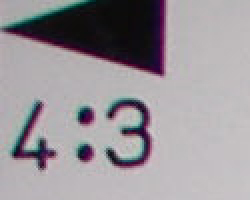 |
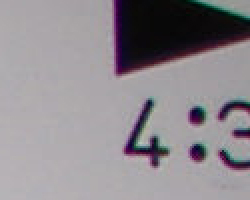 |
| Wide: moderate, top left @ 200% | Wide: fairly bright, top right @ 200% |
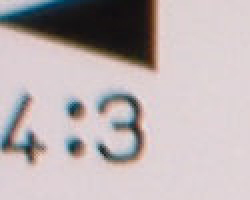 |
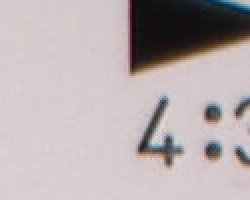 |
| Tele: low CA, but more blurring, top left @200% |
Tele: quite low, top right @200% |
Chromatic aberration is on the high side at wide angle, showing about 6-7 pixels of moderately bright coloration on either side of the target lines, but decreases to very low levels at telephoto focal lengths. (This distortion is visible as a very slight colored fringe around the objects at the edges of the field of view on the resolution target.)
Corner Sharpness
Some softening in the left and right corners of the frame, strongest effect in the upper right corner.
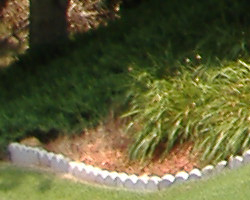 |
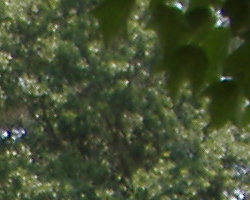 |
| Slightly soft in the lower left corner. | Soft in top right corner. |
The FinePix A345 produced soft corners in a few shots, though the upper right corner seemed to have the most visible effect. Most consumer digital camears show this effect to some degree, the amount shown here is more than most, but doesn't extend very far into the frame.
Sensor
Exposure and White Balance
Indoors, incandescent lighting
Moderate warm cast with both Auto and Incandescent white balance settings. Less exposure compensation required than usual.
| Auto White Balance +0.6 EV | Incandescent WB +0.6 EV |
Color balance indoors under both Auto and Incandescent lighting was just a bit warm and reddish but on the whole fairly pleasing. The FinePix A345 required a +0.6 EV exposure compensation boost to get a good exposure, a bit less than most cameras need on this shot. Our test lighting for this shot is a mixture of 60 and 100 watt household incandescent bulb, a pretty yellow light source, but a very common one in typical home settings here in the US.
Outdoors, daylight
Good color balance, bright colors. Better than average exposure accuracy.
| Auto White Balance, Auto Exposure | Auto White Balance, +0.3 EV |
Outdoor shots generally showed accurate exposure with slightly blown out highlights. Shadow detail also tended to fall apart, but nothing that would raise an alarm for a consumer camera in this price range. Sunlit shots showed high contrast and some oversaturation while overcast scenes managed a more accurate portrayal. Exposure accuracy overall was better than average, the camera requiring less exposure compensation than we're accustomed to seeing with consumer digicams.
See full set of test images with explanations
See thumbnails of all test and gallery images
Resolution
Moderately high resolution, 1,050 - 1,100 lines of strong detail.
Our laboratory resolution chart revealed sharp, distinct line patterns down to between 1,050 and 1,100 lines per picture height, with extinction at around 1,400 lines. (The camera did produce slight color artifacts at lower line frequencies though, visible in the full-sized res target shots.) Use these numbers to compare with other cameras of similar resolution, or use them to see just what higher resolution can mean in terms of potential detail. Beware that while you might be able to make out what looks like distinct lines at numbers higher than those we've mentioned here, the camera is just doing its best to continue interpreting the lines. If you zoom in and follow them from the wider portions, you'll see the lines converge and reappear several times, so the lines you see at 1,500 and higher are really only artifacts generated by the camera's imaging system.
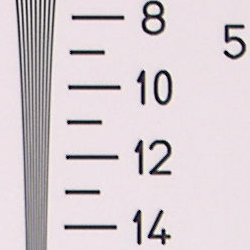 |
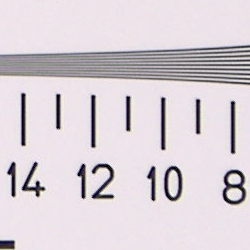 |
| Strong detail to 1,050-1,100 lines horizontal | Strong detail to 1,050-1,100 lines vertical |
See full set of test images with explanations
See thumbnails of all test and gallery images
Sharpness & Detail
Slightly soft images, with some blurring of detail from noise suppression.
The FinePix A345's images are slightly soft, only minor over-sharpening or edge enhancement on the camera's part. (Edge enhancement creates the illusion of sharpness by enhancing colors and tones right at the edge of a rapid transition in color or tone.)
Noise-suppression systems in digital cameras tend to flatten-out detail in areas of subtle contrast. The effects can often be seen in shots of human hair, where the individual strands are lost and an almost "watercolor" look appears. The crop above right shows this, with darker areas of Marti's hair showing only limited detail, even though individual strands are quite visible against her cheek in the uncropped image. (The level of detail loss shown here isn't all that obvious on prints 8x10 inches or smaller though.)
ISO & Noise Performance
Moderate noise under normal lighting, increasing loss of subtle detail as ISO is boosted under low light conditions.
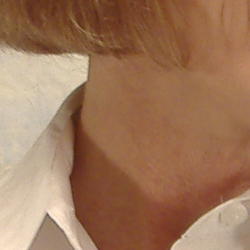 |
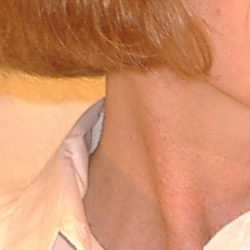 |
| ISO 100 | ISO 400 (w/flash) |
The FinePix A345 automatically sets sensitivity between ISO 64 and 400 equivalents. Our test shots show only one setting for each setup because ISO is controlled automatically by the camera, not the user. (The camera only went higher than ISO 100 under very dark conditions, and appears to only use the ISO 400 level for flash photos in fairly dark surroundings.) At ISO 100, the FinePix A345 produced moderate noise, with only slightly blurred detail in the dark areas. As the ISO setting increases, so does the noise level and the amount of blurring that results. Flash shots at ISO 400 were a little more noisy, but not too bad.
Extremes: Sunlit and low light tests
High resolution with good overall detail, but high contrast and limited shadow detail. Pretty good low-light performance, capable of capturing bright images under average city street lighting and slightly darker conditions.
| Normal | +0.3EV | +0.7EV |
Sunlight:
Because digital cameras are more like slide film than negative film (in that they tend to have a more limited tonal range), we test them in the harshest situations to see how they handle scenes with bright highlights and dark shadows, as well as what kind of sensitivity they have in low light. The shot above is designed to mimic the very harsh, contrasty effect of direct noonday sunlight, a very tough challenge for most digital cameras. (You can read details of this test here.)
The FinePix A345 had a little trouble with the deliberately harsh lighting in the test above, producing very high contrast with washed-out highlights and deep shadows. Noise suppression is visible in both shadows and highlights as well, contributing to the loss of detail. (In "real life" though, be sure to use fill flash in situations like the one shown above; it's better to shoot in the shade when possible.)
| 1 fc 11 lux |
1/2 fc 5.5 lux |
1/4 fc 2.7 lux |
1/8 fc 1.3 lux |
1/16 fc 0.67 lux |
|
| ISO 200 |
2 sec f2.8 |
2 sec f2.8 |
2 sec f2.8 |
2 sec f2.8 |
2 sec f2.8 |
Low light:
Our low light testing revealed some limitations in the lens and sensor's ability to gather and process light, but the FinePix A345's performance in this area will be more than adequate for most consumers, provided they know to switch to "Night" mode for after-dark photography. The Night mode forces the ISO setting to 200 to control image noise (vs the noise that would occur at ISO 400), but permits shutter times as long as two seconds. The net result in Night mode was that our test images were bright as low as 1/2 foot-candle, which is about 1/2 as bright as average city street lighting at night. Color balance was slightly warm from the Auto white balance setting. The camera's autofocus system worked unusually well, able to focus on the subject down to the darkest light levels we test at. Do keep in mind though, that the very long shutter times associated with Night Landscape mode absolutely demand the use of a tripod or other camera support to get sharp photos. (A useful trick is to just prop the camera on a convenient surface, and use its self-timer to release the shutter. This avoids any jiggling from your finger pressing the shutter button, and can work quite well when you don't have a tripod handy.)
Color
Saturation & Hue Accuracy
Hue shifts and very high saturation in strong blues and purples, good color accuracy otherwise.
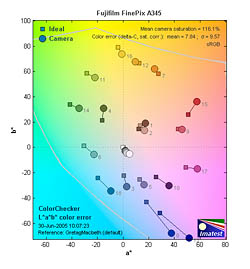 |
| In the diagram above, the squares show the original color, and the circles show the color that the camera captured. More saturated colors are located towards the periphery of the graph. Hue changes as you travel around the center. Thus, hue-accurate, highly saturated colors appear as lines radiating from the center. |
The other important part of color rendition is hue accuracy. Hue is "what color" the color is. Here, the FinePix A345 did quite well. Like most digicams, it shifts cyan colors toward blue, to produce better-looking sky colors. Deeper blues are shifted toward purple slightly, but the rest of the hues were quite accurate.
Viewfinder
Coverage
Optical viewfinder is very tight and skewed to the upper right. Very good accuracy from the LCD monitor.
| 35mm eq., optical viewfinder | 105mm eq., optical viewfinder |
| 35mm eq., LCD monitor | 105mm eq., LCD monitor |
The A345's optical viewfinder was unusually tight, showing only 77% of the final frame area at wide angle, and 81% at telephoto zoom settings, and appeared to be rotated slightly with respect to the camera's sensor position. However, the LCD monitor showed about 99 percent frame accuracy regardless of zoom position.
Flash
Coverage and Range
The A345's small flash has a limited range, and produces a slight blue cast in combination with typical incandescent room lighting. Our standard shots required more exposure compensation than average.
| 36mm equivalent | 108mm equivalent |
| Normal Flash +0.9 EV | Slow-Sync Mode +0.6 EV |
Flash coverage was rather uneven at wide angle but very good at telephoto. In the Indoor test, the flash on the A345 underexposed our subject at its default setting, requiring a +0.9 EV exposure compensation adjustment to get reasonably bright results. (About the usual amount for this particular shot.) The camera's Slow-Sync flash mode produced brighter results, though with a slightly stronger warm cast from the room lighting; a +0.6 EV adjustment was required. Overall results indoors under incandescent lighting were quite good.
| 8 ft | 9 ft | 10 ft | 11 ft | 12 ft | 13 ft | 14 ft |
1/30 sec f4.7 ISO 400 |
1/30 sec f4.7 ISO 400 |
1/30 sec f4.7 ISO 400 |
1/30 sec f4.7 ISO 400 |
1/30 sec f4.7 ISO 400 |
1/30 sec f4.7 ISO 400 |
1/30 sec f4.7 ISO 400 |
At eight feet, our closest test range, the flash illuminated the DaveBox target adequately, and did so out to a range of 10 feet or so. This agrees with Fujifilm's own spec of 11.5 - 9.8 feet for flash range (for wide angle to telephoto focal lengths), about average for a compact camera model. A significant problem with the A345's flash though, is that the camera boosts its ISO to 400 for flash shots in very dark surroundings. (Our flash tests shown above are shot in total darkness.) This has the benefit of boosting flash range considerably (doubling it relative to performance at ISO 100), but at a terrible cost in image noise. Flash shots from the A345 captured in very dark surroundings really aren't usable for anything above 4x6 inch snapshot prints, and will look a little rough even at that modest size.
Output Quality
Print Quality
Good print quality, decent color, usable 8x10 inch prints. ISO 400 images (flash photos in very dark conditions) are very soft, marginally usable at 4x6.
Testing hundreds of digital cameras, we've found that you can only tell just so much about a camera's image quality by viewing its images on-screen. Ultimately, there's no substitute for printing a lot of images and examining them closely. For this reason, we now routinely print sample images from the cameras we test on our Canon i9900 studio printer, and on the Canon iP5000 here in the office. (See the Canon i9900 review for details on that model.)
With the FinePix A345, we found that it had enough resolution to make good-looking 8x10 inch prints, although 5x7s were sharper. These print sizes are a little small in comparison to the best 4-megapixel cameras out there, but aren't bad when the A345's low selling price is factored into the equation. At high ISO, image noise levels are held in check, but at the cost of rather soft-looking images. ISO 200 photos look rough printed at 8x10 inches, but ISO 400 ones are marginal even at 4x6 inches. Color-wise, the FinePix A345's images looked pretty good when printed on the i9900, but greens and yellows were a bit undersaturated, while blues were over-bright and very intense. Overall, we found the A345's color a little disappointing, not what we've come to expect from Fujifilm.
Timing and Performance
FinePix A345 Timing
Average to slow speed for a consumer camera.
| Startup/Shutdown: | |
| Power On to first shot | 3.3 seconds |
| Shutter response (Lag Time): | |
| Full Autofocus Wide |
0.81 second |
| Full Autofocus Tele |
1.44 second |
| Prefocused |
0.292 second |
| Cycle time (shot to shot) | |
| Normal large/fine JPEG | 3.17 seconds |
| Flash recycling | 6 seconds |
| Continuous mode | 0.74 second 1.34 frames/second (3 large/fine frames) |
| Download speed | |
| Windows Computer, USB 2.0 | 848 KBytes/sec |
The A345's performance ranges from just average to slow, depending on what you're trying to do. Start up falls in the average range. Shutter response when the lens is set to its wide angle position is slightly slower than average. At the telephoto end of the lens' range though, the lag time of 1.44 second is quite a bit slower than average. On the other hand, if you "prefocus" the camera by half-pressing and holding down the shutter button before the final exposure, it's much faster, with a shutter delay of 0.29 second, about average for inexpensive point & shoot digital cameras. Shot-to-shot cycle times are also on the slow side of average, at 3.17 seconds for large/fine JPEGs. There is no buffer memory, all shots are this speed, regardless of how many you've snapped in succession. Continuous-mode speed is average for an inexpensive camera, at a bit over one frame/second, for up to five shots in succession. The flash takes about seven seconds to recharge after a full-power shot, about average for this class of camera. Connected to a computer, download speeds are fast enough (848 KB/second) that you probably won't feel a need for a separate card reader, but nonetheless aren't as fast as many cameras currently on the market. Bottom line, while not a first choice for sports or other fast-paced action, the A345 is responsive enough (particular at wide angle lens settings) to handle most family photo opportunities.
Battery and Storage Capacity
Battery
Pretty good battery life.
| |
|
| Still-image capture mode LCD on |
149 minutes |
| Still-image capture mode LCD off |
168 minutes |
| Image playback LCD on |
372 minutes |
The FinePix A345 uses two AA batteries for power. The table above shows maximum run times based on our power measurements and standard 1600 mAH Ni-MH batteries (although higher capacity batteries are now available, so you can expect run times up to 25% longer than those shown). With a worst-case run time of over two and a half hours, the A345 does better than average in this department. (But do plan on purchasing a couple of sets of high-capacity NiMH rechargeable batteries and a good-quality charger along with the camera.)
Storage
A 16-MB xD-Picture Card is included with the FinePix A345, plan on buying a larger one.
| 16-MB xD Picture Card |
Fine | Normal | |
| 2,304 x 1,728 | Images | 8 | 16 |
| File Size | 2.0MB | 996KB | |
| 1,600 x 1,200 | Images | - | 25 |
| File Size | - | 626K | |
| 1,280 x 960 | Images | - | 34 |
| File Size | - | 465K | |
| |
Images | - | 124 |
| File Size | - | 128K | |
I strongly recommend buying at least a 128MB card, preferably a 256MB one, to give yourself extra space for extended outings. (Here's a link where you can shop for Large capacity xD memory cards.)
| Pro: | Con: |
|---|---|
|
|
| Free Photo Lessons | |
|
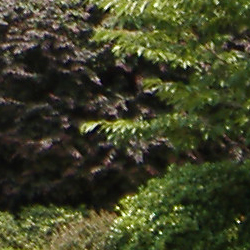
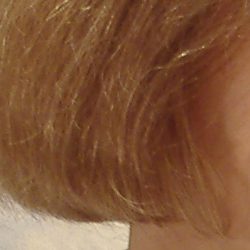


Follow Imaging Resource: